#living well
Text
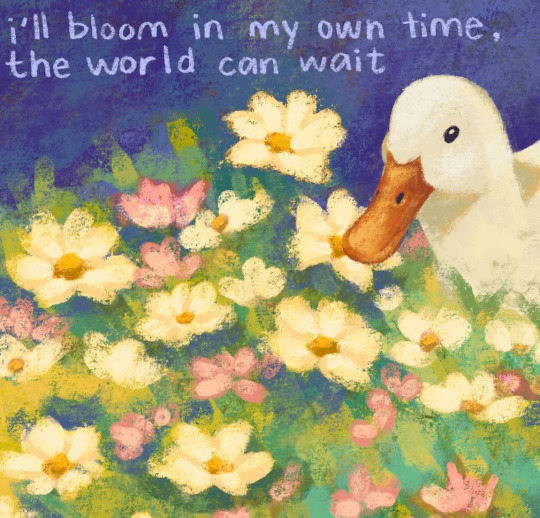
#be happy#living for myself#living well#one day at a time#self love#loving life#loving#love yourself#good life#new living#living unapologetically#live for today#mental health#self reflection#be yourself#self improvement#new life#letting go#self help#inspirational quotes#new beginnings#positivity#mental growth#manifesting#inspiration#inspiring#inspiring quotes
9K notes
·
View notes
Note
Aaaaah I thought of another scene that I’d love commentary on as well!!! I hope this one isn’t too long either!
From “Living Well”:
Mr. Midoriya released his hand from the handshake to turn to Izuku, who now stood behind him. Toshinori noted that the boy stood rather rigidly, which only grew worse as his father grabbed him by the shoulder and roughly pulled him to his side. Toshinori’s own smile faltered at the sight of it.
“That’s what I hear!” Mr. Midoriya said, his smile only growing wider. “I never would have thought I’d hear that about my boy, from All Might no less, but I couldn’t be prouder!”
Toshinori’s heart seized. His eyes flicked over to young Midoriya, whose face was scrunched up in an unreadable expression and his eyes downcast. Putting his hand in his pocket in a clenched fist, Toshinori glanced back at Mr. Midoriya.
“Well, you certainly have every reason to be.”
Young Midoriya glanced up at that. When Toshinori met his eyes, he gave him a small smile, one that the boy sheepishly returned. The moment ended abruptly, though, when Mr. Midoriya tousled the boy’s hair with a closed fist. Young Midoriya looked down again, flinching slightly at the contact, while Toshinori glanced away. Looking at the shelf for a distraction, he noticed the protein bars he had come into this aisle for. He picked a box up off the shelf and held it out before him.
“You weren’t looking for these by any chance when you came down here, were you?” Toshinori held it in young Midoriya’s direction when Mr. Midoriya took the box from him, glanced at it, then showed it to the boy himself.
“Was this the brand you wanted, Izuku?” The boy gave a slight nod and a momentary glance at Toshinori.
“Yeah, that was it.”
“Lucky guess!” Mr. Midoriya said, handing the box to the boy, who took it with both hands. Toshinori swallowed a lump in his throat.
“Actually, I was just buying a few boxes as well.”
Young Midoriya glanced up at him once more as Toshinori kept the end of that sentence to himself while looking at the boy.
For you. I was buying them for you.
Oh my God, anon, thank you so much for asking about Chapter 2 of Living Well for the ask game! I really enjoyed writing this scene and this moment in particular because there were so many layers to what was going on here. (In fact, this scene relates pretty well to what I just posted on writing emotions.)
So at this point, Hisashi has no idea how awkward both All Might and Izuku are feeling right now, which is why he's able to act so casual. What I wanted to specifically show here is that because Hisashi doesn't know what's going on, he will readily say and do things that actively highlight the awkwardness of the interaction for All Might and Izuku in subtle yet important ways.
The whole point of this scene then is for both Izuku and All Might to start actively facing why it's awkward. Having someone step in and interact with Izuku the way that All Might normally does, and having that person be his father, plants the seed in both of their minds that oh, this is how we normally look and oh, why does this seem off when it's coming from someone else?
I chose to have Hisashi and Izuku running into All Might buying food for Izuku specifically because I wanted Izuku to see two things. First, that All Might regularly thinks about him when he's not around. Second, that All Might knows him better than his own father.
The other reason I chose this interaction is because I wanted Toshinori to confront the caring thoughts he has towards Izuku that he doesn't let himself say out loud, specifically with the last line here. It's one thing to choose not to say his thoughts out loud. It's another thing to be unable to say them.
23 notes
·
View notes
Text

2 notes
·
View notes
Photo
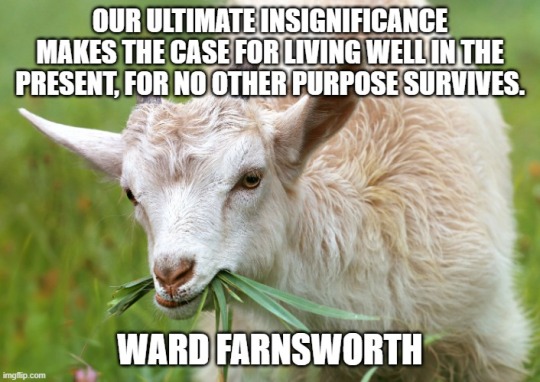
#ward farnsworth#insignificant#living well#stoic#stoicism#goat#goats#goats and quotes#the stoic goat
90 notes
·
View notes
Text
Live longer by living better, says Seneca
According to a myth referred to by Aeschylus in his play Prometheus Bound, at the beginning of time human beings had foreknowledge of when they would die. Among the gifts that Prometheus gave to humankind, along with fire and all the technologies that spring from it, was obliviousness to that knowledge. Knowing one’s expiration date, in the god’s view, prevented one from undertaking anything meaningful. That terminus was always lurking and shadowing one’s every move. Anticipation of the end would induce a kind of paralysis.
The absence of such knowledge however leads to a failing of a different kind, as Seneca observes in his essay On the Shortness of Life. Because we can’t truly conceive of an endpoint to life, we give to our time far less value than we should, squandering it on useless pursuits or frivolities. We behave like the author or journalist who hasn’t been given a deadline and who puts off starting a writing task year after year (I speak from experience here). If our editor suddenly calls for the piece, or if death suddenly looms (not to compare book editors with the grim reaper), we are struck with remorse for the time that has passed us by. If we’d realized early on that our lifespans are short, in calendar terms, we might have lengthened them considerably, by using every moment to the fullest and giving to time the value it deserves.
Readers of Seneca, a Roman Stoic philosopher who also served as chief minister to emperor Nero, will not be surprised that the nearness of death plays such a large role in this essay’s treatment of time. For Seneca, death was the great, overriding truth about life, a subject explored in many passages of his ethical treatises (the crucial ones are collected in my first contribution to Princeton’s Ancient Wisdom for Modern Readers series, How to Die). All of life, as Seneca saw it, is really a journey toward death; we say of terminal patients “they’re dying,” but really that sentence applies just as well to newborn babies or youths in their prime. Cottidie morimur, Seneca wrote on two different occasions: “We are dying every day.” And that perspective led him toward a deeper, more urgent understanding of time than most of us can lay claim to.
24 notes
·
View notes
Text
6 notes
·
View notes
Text
This is exactly what teenagers in Brooklyn should be doing: Reading books they don’t understand, getting into trouble, trying on intellectual identities without worrying about widespread scrutiny, sewing their own jeans, and yes, if they want, whittling sticks. How long did we really think young people would be willing to give up all of this wonderful mess in exchange for monotonously boosting the value of Meta stock?
— Cal Newport
16 notes
·
View notes
Text
“Ten Feline Hints on How to Live Well” from Feline Philosophy by John Gray (2020)
1 Never try to persuade human beings to be reasonable
2 It is foolish to complain that you do not have enough time
3 Do not look for meaning in your suffering
4 It is better to be indifferent to others than to feel you have to love them
5 Forget about pursuing happiness, and you may find it
6 Life is not a story
7 Do not fear the dark, for much that is precious is found in the night
8 Sleep for the joy of sleeping
9 Beware anyone who offers to make you happy
10 If you can't learn to live a little more like a cat, return without regret to the human world of diversion
#feline#felines#cats#feline philosophy#philosophy#john gray#the meaning of life#meaning of life#ten hints#hints#how to live well#live well#living well#live like a cat#like a cat#catlike#cat like#learn to live#learn to live a little#live a little#list of ten
8 notes
·
View notes
Text
I'll never pretend it's easy, or try to sell you a quick fix. Living well takes discipline, courage, and a deep love for oneself. We'll get there. I believe in you.
Read more here: https://wisterianwoman.com/2023/04/17/its-hard/
instagram
#wellness#health#mentalhealth#mental health#mental health awareness#struggle#fitness journey#healthy habits#success#therapy#growth#wellnessjourney#goals#selfwork#courage#living well#Instagram
3 notes
·
View notes
Text
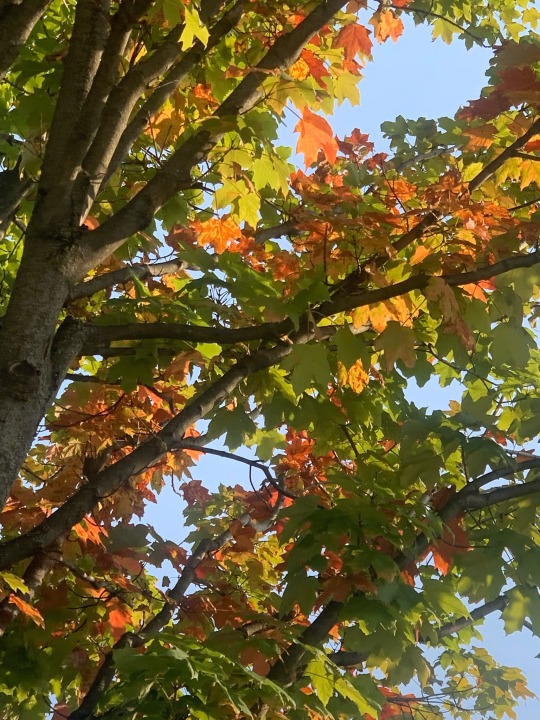
The Tree Around the Corner and Down the Street
Most days, the Tree Around the Corner and Down the Street is nothing spectacular. It stands at the edge of a typical suburban yard near a typical suburban ranch house that has seen a few owners over the course of my 20-plus-year residency in my subdivision. The tree is of average height and width for its kind. Its trunk and branches are a common brownish gray. The tree bears no flowers or fruit, nor harbors any animals other than the occasional sparrow or squirrel that might find it suitable for a momentary rest. Throughout most of the year, this unassuming tree is passed by a walker, jogger, bicyclist or driver without a second glance.
Until early August.
For it is then, amongst the first sights and sounds of the returning school buses, that The Tree Around the Corner and Down the Street turns bold. It becomes the first tree in the neighborhood to change color – not by a mere few days but by many weeks. For those who are blessed to witness it, like the return of the robin signaling the approach of spring, this rogue and fearless action by this otherwise unpretentious tree serves as a visual announcement of the transition toward autumn.
Each year when this event occurs, seemingly overnight, I pause in my comings and goings to take in the blaze of red, orange and yellow patches beginning to form in the midst of the tree’s greenery. This is both a joyous and sobering occasion for me. On one hand, I feel a sense of excitement at the return of familiar schedules and routines, cozy sweaters and boots, and the approach of some of my favorite fall holidays and traditions. On the other hand, I am saddened by the ending of summer and all of its welcomed sunshine, warmth, unhurried freedoms and outdoor adventures.
Even more so, The Tree Around the Corner and Down the Street has made me deeply aware of the passage of time, the sense of another year lived and the changes -both good and bad – that have come with that living. That awareness, in turn, leads me to ponder important life questions: Am I living well? Am I living as my truest self on my truest path? Am I living boldly?
Perhaps these answers, too, can be found in the story of The Tree Around the Corner and Down the Street.
What causes this ordinary tree to become extraordinary – at least to our human eyes – even for just a short period of time each year? It grows from the same soil, receives the same sunlight, is watered by the same rains and braces against the same winds as the other deciduous neighborhood trees. Yet in early August, while those other trees grip firmly to their greenness, The Tree Around the Corner and Down the Street bravely lets go…of what is comfortably familiar and what is expected of it.
By turning to science, we discover that this phenomena isn’t a sappy (no tree pun intended) sentimental tale but rather a solid story of greatness being born from adversity. Tree leaves begin to change color because of a lack of chlorophyll, a plant pigment responsible for the absorption of light. As the days get shorter and cooler, less sunlight means less chlorophyll production, hence the changing color and eventual dropping of leaves. However, a tree may also stop producing chlorophyll if it perceives a threat to its well-being, such as insects, disease, nutritional deficiencies or damage to its roots. Biologists say that a tree’s unusually early color change is a defense mechanism that allows the stressed out tree to try to save itself.
Indeed, contrary to what one might first believe, the Tree Around the Corner and Down the Street isn’t stronger than the other trees around it. It’s actually weaker, plagued by difficulties not necessarily visible to the untrained eye. But in that weakness, there is still room for beauty and hope for growth and renewal.
This special tree teaches us that living boldly and beautifully does not mean living with an absence of problems but rather persevering in spite of them. Instinctually, it knows what to do to try to heal itself, even if those actions do not conform to a traditional timetable. For much longer than its still-green counterparts, The Tree Around the Corner and Down the Street is willing to stand alone, stark and leafless in the dark and colder days to come, because it knows its journey is different than the others.
I hope we, too, will acknowledge and respect the differences in our individual healing journeys, the beauty in our unique battles, and the God-given right of and necessity for each of us to sit patiently and bravely in our own personal storms until – one glorious day – we feel we are ready to bloom again.
#tree#autumn#August#living well#living boldly#healing#journey#leaves#science#adversity#strength#weakness#neighborhood#fall#color change
2 notes
·
View notes
Text
The last Destiny story I disliked as much as Plunder was Curse of Osiris, which felt similarly disjointed and weird about exposition (although perhaps in the opposite direction iirc). Also similarly, it had some great character moments in a muddled overall story. Plunder hit me harder because it's about characters I'm more invested in, and shows the dark side of long-term story; long-term and indefinitely delayed consequences. Perpetually, I miss Ishtar leaks because I don't like the person I am when I'm on tenterhooks over a video game story that isn't any more "real" than any other story
#destiny 2#edz salt mines#i was going to make like a point by point critique#but that ain't my job#living well
18 notes
·
View notes
Photo
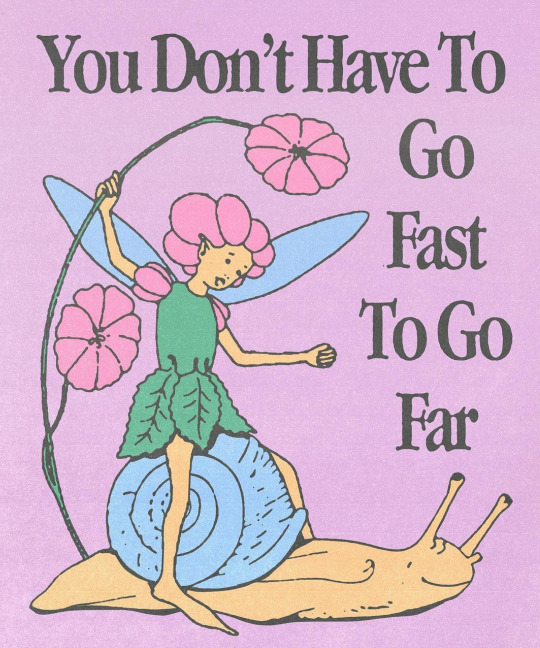
#positivity#reminder#self improvement#self reflection#self help#be yourself#therapy#keep moving forward#moving#move on#moving forward#love#self love#inspirational quotes#inspiring#happiness#life lessons#good life#be happy#living well#living in the present#living for myself#new living#new beginnings#new me#new day#new you
5K notes
·
View notes
Text

#proverb#tibetan proverb#the secret#secret#living well#eat half#walk double#laugh triple#love without measure#live#eat#walk#laugh#love#quotes#life quotes#beautiful quote
2 notes
·
View notes
Text
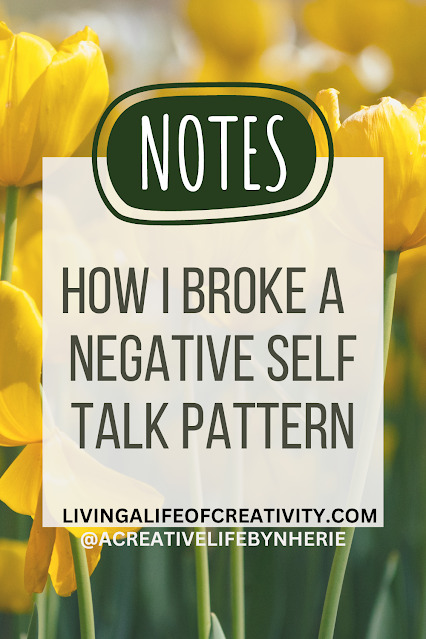
Breaking negative self-talk patterns takes time! But how do you do it? You do it by turning that negatively into a truth instead. Click the link below to read 📚.
#inspiration#motivation#blogpost#living well#selftalk#positive thinking#mentalhealth#mental health#wellness#acreativelifebynherie
5 notes
·
View notes
Text
I love ideas and stories. I always have at least one book going and am on the lookout for the next one. They feed the brain and fuel the imagination. I can’t imagine life without them.
—Dick Van Dyke, Keep Moving: And Other Truths About Living Well Longer
#quotes#dick van dyke#keep moving#living well#reading books#imagination#Keep Moving: And Other Truths About Living Well Longer#text
2 notes
·
View notes
Quote
I shall live badly if I do not write, and I shall write badly if I do not live.
Francoise Sagan
#Francoise Sagan#sagan#quotes#life#wisdom#philosophy#idea#ideas#living well#living badly#living#write#writing#writer
2 notes
·
View notes